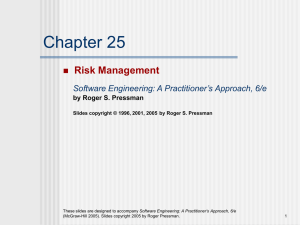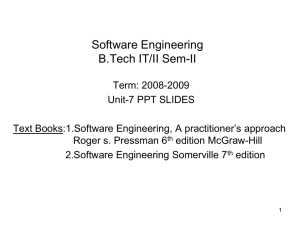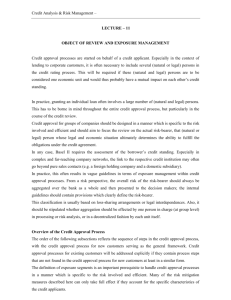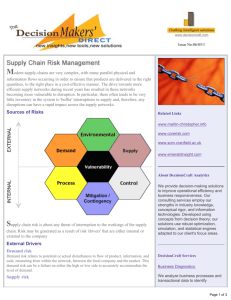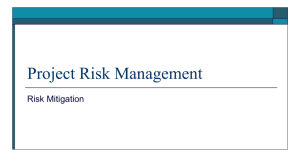Chapter 25 Risk Management
advertisement
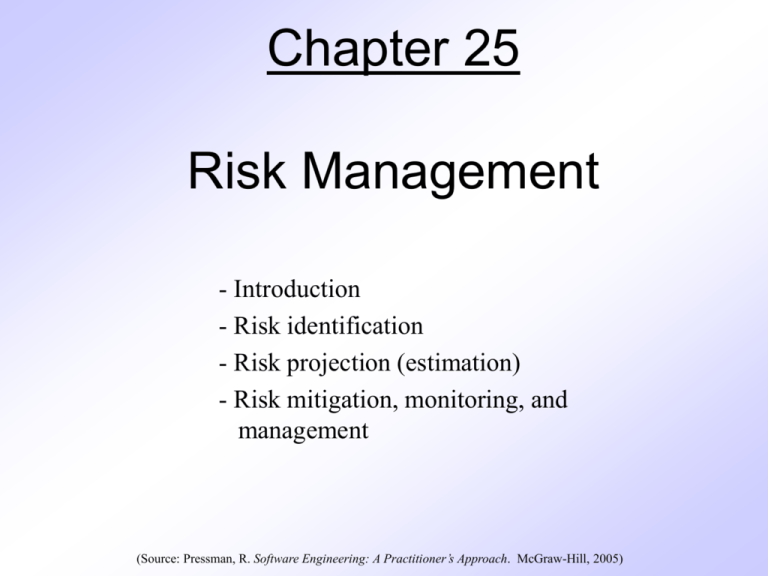
Chapter 25 Risk Management - Introduction - Risk identification - Risk projection (estimation) - Risk mitigation, monitoring, and management (Source: Pressman, R. Software Engineering: A Practitioner’s Approach. McGraw-Hill, 2005) Introduction Definition of Risk • A risk is a potential problem – it might happen and it might not • Conceptual definition of risk – Risk concerns future happenings – Risk involves change in mind, opinion, actions, places, etc. – Risk involves choice and the uncertainty that choice entails • Two characteristics of risk – Uncertainty – the risk may or may not happen, that is, there are no 100% risks (those, instead, are called constraints) – Loss – the risk becomes a reality and unwanted consequences or losses occur 3 Risk Categorization – Approach #1 • Project risks – They threaten the project plan – If they become real, it is likely that the project schedule will slip and that costs will increase • Technical risks – They threaten the quality and timeliness of the software to be produced – If they become real, implementation may become difficult or impossible • Business risks – They threaten the viability of the software to be built – If they become real, they jeopardize the project or the product (More on next slide) 4 Risk Categorization – Approach #1 (continued) • Sub-categories of Business risks – Market risk – building an excellent product or system that no one really wants – Strategic risk – building a product that no longer fits into the overall business strategy for the company – Sales risk – building a product that the sales force doesn't understand how to sell – Management risk – losing the support of senior management due to a change in focus or a change in people – Budget risk – losing budgetary or personnel commitment 5 Risk Categorization – Approach #2 • Known risks – Those risks that can be uncovered after careful evaluation of the project plan, the business and technical environment in which the project is being developed, and other reliable information sources (e.g., unrealistic delivery date) • Predictable risks – Those risks that are extrapolated from past project experience (e.g., past turnover) • Unpredictable risks – Those risks that can and do occur, but are extremely difficult to identify in advance 6 Reactive vs. Proactive Risk Strategies • Reactive risk strategies – "Don't worry, I'll think of something" – The majority of software teams and managers rely on this approach – Nothing is done about risks until something goes wrong • The team then flies into action in an attempt to correct the problem rapidly (fire fighting) – Crisis management is the choice of management techniques • Proactive risk strategies – Steps for risk management are followed (see next slide) – Primary objective is to avoid risk and to have a contingency plan in place to handle unavoidable risks in a controlled and effective manner 7 Steps for Risk Management 1) 2) 3) 4) Identify possible risks; recognize what can go wrong Analyze each risk to estimate the probability that it will occur and the impact (i.e., damage) that it will do if it does occur Rank the risks by probability and impact - Impact may be negligible, marginal, critical, and catastrophic Develop a contingency plan to manage those risks having high probability and high impact 8 Risk Identification Background • Risk identification is a systematic attempt to specify threats to the project plan • By identifying known and predictable risks, the project manager takes a first step toward avoiding them when possible and controlling them when necessary • Generic risks – Risks that are a potential threat to every software project • Product-specific risks – Risks that can be identified only by those a with a clear understanding of the technology, the people, and the environment that is specific to the software that is to be built – This requires examination of the project plan and the statement of scope – "What special characteristics of this product may threaten our project plan?" 10 Risk Item Checklist • Used as one way to identify risks • Focuses on known and predictable risks in specific subcategories (see next slide) • Can be organized in several ways – A list of characteristics relevant to each risk subcategory – Questionnaire that leads to an estimate on the impact of each risk – A list containing a set of risk component and drivers and their probability of occurrence 11 Known and Predictable Risk Categories • Product size – risks associated with overall size of the software to be built • Business impact – risks associated with constraints imposed by management or the marketplace • Customer characteristics – risks associated with sophistication of the customer and the developer's ability to communicate with the customer in a timely manner • Process definition – risks associated with the degree to which the software process has been defined and is followed • Development environment – risks associated with availability and quality of the tools to be used to build the project • Technology to be built – risks associated with complexity of the system to be built and the "newness" of the technology in the system • Staff size and experience – risks associated with overall technical and project experience of the software engineers who will do the work 12 Questionnaire on Project Risk (Questions are ordered by their relative importance to project success) 1) 2) 3) 4) 5) 6) Have top software and customer managers formally committed to support the project? Are end-users enthusiastically committed to the project and the system/product to be built? Are requirements fully understood by the software engineering team and its customers? Have customers been involved fully in the definition of requirements? Do end-users have realistic expectations? Is the project scope stable? (More on next slide) 13 Questionnaire on Project Risk (continued) 7) 8) 9) 10) 11) Does the software engineering team have the right mix of skills? Are project requirements stable? Does the project team have experience with the technology to be implemented? Is the number of people on the project team adequate to do the job? Do all customer/user constituencies agree on the importance of the project and on the requirements for the system/product to be built? 14 Risk Components and Drivers • The project manager identifies the risk drivers that affect the following risk components – Performance risk - the degree of uncertainty that the product will meet its requirements and be fit for its intended use – Cost risk - the degree of uncertainty that the project budget will be maintained – Support risk - the degree of uncertainty that the resultant software will be easy to correct, adapt, and enhance – Schedule risk - the degree of uncertainty that the project schedule will be maintained and that the product will be delivered on time • The impact of each risk driver on the risk component is divided into one of four impact levels – Negligible, marginal, critical, and catastrophic • Risk drivers can be assessed as impossible, improbable, probable, and frequent 15 Risk Projection (Estimation) Background • Risk projection (or estimation) attempts to rate each risk in two ways – The probability that the risk is real – The consequence of the problems associated with the risk, should it occur • The project planner, managers, and technical staff perform four risk projection steps (see next slide) • The intent of these steps is to consider risks in a manner that leads to prioritization • Be prioritizing risks, the software team can allocate limited resources where they will have the most impact 17 Risk Projection/Estimation Steps 1) 2) 3) 4) Establish a scale that reflects the perceived likelihood of a risk (e.g., 1-low, 10-high) Delineate the consequences of the risk Estimate the impact of the risk on the project and product Note the overall accuracy of the risk projection so that there will be no misunderstandings 18 Contents of a Risk Table • A risk table provides a project manager with a simple technique for risk projection • It consists of five columns – – – – – Risk Summary – short description of the risk Risk Category – one of seven risk categories (slide 12) Probability – estimation of risk occurrence based on group input Impact – (1) catastrophic (2) critical (3) marginal (4) negligible RMMM – Pointer to a paragraph in the Risk Mitigation, Monitoring, and Management Plan Risk Summary Risk Category Probability (More on next slide) Impact (1-4) RMMM 19 Developing a Risk Table • List all risks in the first column (by way of the help of the risk item checklists) • Mark the category of each risk • Estimate the probability of each risk occurring • Assess the impact of each risk based on an averaging of the four risk components to determine an overall impact value (See next slide) • Sort the rows by probability and impact in descending order • Draw a horizontal cutoff line in the table that indicates the risks that will be given further attention 20 Assessing Risk Impact • Three factors affect the consequences that are likely if a risk does occur – Its nature – This indicates the problems that are likely if the risk occurs – Its scope – This combines the severity of the risk (how serious was it) with its overall distribution (how much was affected) – Its timing – This considers when and for how long the impact will be felt • The overall risk exposure formula is RE = P x C – P = the probability of occurrence for a risk – C = the cost to the project should the risk actually occur • Example – P = 80% probability that 18 of 60 software components will have to be developed – C = Total cost of developing 18 components is $25,000 – RE = .80 x $25,000 = $20,000 21 Risk Mitigation, Monitoring, and Management Background • An effective strategy for dealing with risk must consider three issues (Note: these are not mutually exclusive) – Risk mitigation (i.e., avoidance) – Risk monitoring – Risk management and contingency planning • Risk mitigation (avoidance) is the primary strategy and is achieved through a plan – Example: Risk of high staff turnover (see next slide) (More on next slide) 23 Background (continued) Strategy for Reducing Staff Turnover Meet with current staff to determine causes for turnover (e.g., poor working conditions, low pay, competitive job market) Mitigate those causes that are under our control before the project starts Once the project commences, assume turnover will occur and develop techniques to ensure continuity when people leave Organize project teams so that information about each development activity is widely dispersed Define documentation standards and establish mechanisms to ensure that documents are developed in a timely manner Conduct peer reviews of all work (so that more than one person is "up to speed") Assign a backup staff member for every critical technologist 24 Background (continued) • During risk monitoring, the project manager monitors factors that may provide an indication of whether a risk is becoming more or less likely • Risk management and contingency planning assume that mitigation efforts have failed and that the risk has become a reality • RMMM steps incur additional project cost – Large projects may have identified 30 – 40 risks • Risk is not limited to the software project itself – Risks can occur after the software has been delivered to the user (More on next slide) 25 Background (continued) • Software safety and hazard analysis – These are software quality assurance activities that focus on the identification and assessment of potential hazards that may affect software negatively and cause an entire system to fail – If hazards can be identified early in the software process, software design features can be specified that will either eliminate or control potential hazards 26 The RMMM Plan • The RMMM plan may be a part of the software development plan (Paragraph 5.19.1) or may be a separate document • Once RMMM has been documented and the project has begun, the risk mitigation, and monitoring steps begin – Risk mitigation is a problem avoidance activity – Risk monitoring is a project tracking activity • Risk monitoring has three objectives – To assess whether predicted risks do, in fact, occur – To ensure that risk aversion steps defined for the risk are being properly applied – To collect information that can be used for future risk analysis • The findings from risk monitoring may allow the project manager to ascertain what risks caused which problems throughout the project 27 Seven Principles of Risk Management • Maintain a global perspective – View software risks within the context of a system and the business problem that is is intended to solve • Take a forward-looking view – Think about risks that may arise in the future; establish contingency plans • Encourage open communication – Encourage all stakeholders and users to point out risks at any time • Integrate risk management – Integrate the consideration of risk into the software process • Emphasize a continuous process of risk management – Modify identified risks as more becomes known and add new risks as better insight is achieved • Develop a shared product vision – A shared vision by all stakeholders facilitates better risk identification and assessment • Encourage teamwork when managing risk – Pool the skills and experience of all stakeholders when conducting risk management activities 28 Summary • Whenever much is riding on a software project, common sense dictates risk analysis – Yet, most project managers do it informally and superficially, if at all • However, the time spent in risk management results in – Less upheaval during the project – A greater ability to track and control a project – The confidence that comes with planning for problems before they occur • Risk management can absorb a significant amount of the project planning effort…but the effort is worth it 29
